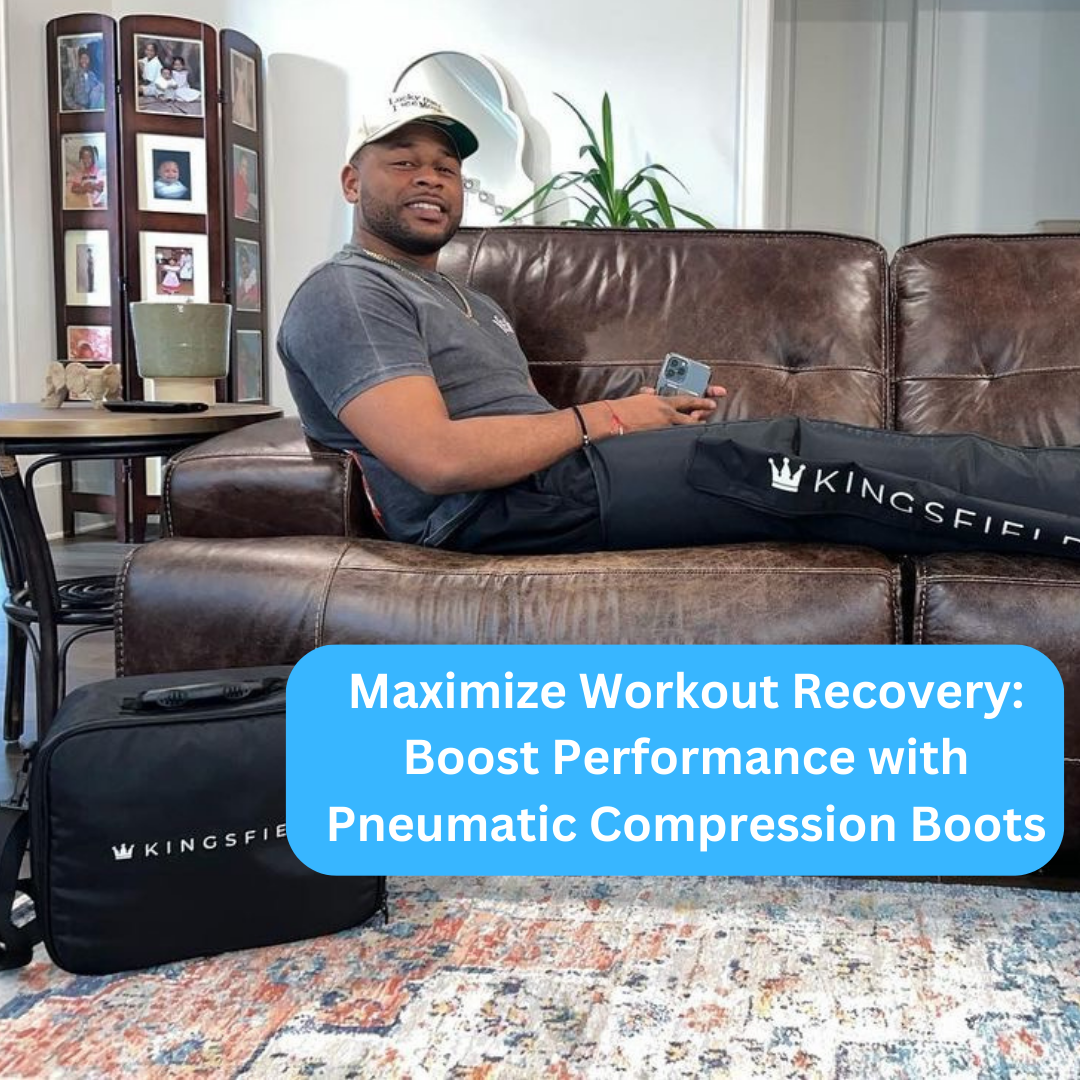Enhancing Workout Recovery with Compression Therapy: How Pneumatic Boots Can Reduce Muscle Fatigue and Speed up Healing
After an intense workout or training session, proper recovery is essential for athletes and fitness enthusiasts to optimize their performance and prevent injuries. While traditional recovery methods like rest, hydration, and nutrition play a crucial role, incorporating compression therapy, specifically using pneumatic boots, can significantly enhance workout recovery. In this article, we will explore how pneumatic boots can reduce muscle fatigue and speed up the healing process.
Understanding Compression Therapy

Compression therapy involves the application of external pressure to specific body parts to enhance blood circulation and facilitate recovery. Pneumatic boots are a type of compression therapy that provides targeted compression to the legs and feet.
How Pneumatic Boots Work
Pneumatic boots have inflatable chambers that wrap around the legs and feet. These chambers are connected to a programmable device that controls the compression level and sequence. When activated, the boots fill with air, applying graduated pressure that helps improve blood flow and reduce muscle fatigue.
The compression from pneumatic boots works by aiding the venous return, which is the process of blood flowing back to the heart. The boots' sequential compression mimics the natural muscle pump mechanism, promoting better circulation and preventing blood stagnation in the lower limbs. Several studies have shown these benefits to be true.
The Benefits of Pneumatic Compression Therapy
Pneumatic compression therapy using boots offers numerous benefits for enhancing workout recovery:
- Reduced Muscle Fatigue: The compression applied by pneumatic boots helps to flush out metabolic waste products, such as lactic acid, which can contribute to muscle fatigue. By promoting better blood flow and lymphatic drainage, pneumatic boots can help speed up the recovery of fatigued muscles.
- Enhanced Muscle Repair: The improved blood circulation facilitated by pneumatic boots allows for a more efficient delivery of oxygen and nutrients to the muscles. This promotes muscle repair and helps accelerate the healing process, allowing athletes to recover faster between workouts or training sessions.
- Reduced Swelling and Inflammation: Pneumatic boots can aid in reducing swelling and inflammation in the legs and feet. The targeted compression helps to alleviate post-workout edema, which can improve overall comfort and range of motion during recovery.
- Improved Range of Motion: By reducing muscle fatigue and inflammation, and promoting better blood flow, these boots can enhance flexibility and range of motion. This can be especially beneficial for athletes engaging in high-intensity training or sports that require optimal joint mobility.
- Enhanced Recovery Between Sessions: Incorporating pneumatic boots into a regular recovery routine can help athletes and fitness enthusiasts recover more quickly and effectively between sessions. This allows for more frequent and higher-quality workouts, leading to improved overall performance.
Pneumatic compression therapy with boots is suitable for a variety of individuals, including athletes, runners, fitness enthusiasts, and those undergoing physical therapy or rehabilitation.
With their ease of use and adjustable compression levels, pneumatic boots provide a convenient and effective method for enhancing workout recovery and optimizing athletic performance. However, it's important to note that while pneumatic compression therapy can be beneficial, it should not replace other essential recovery practices such as proper nutrition, hydration, sleep, and active rest.
In the pursuit of peak performance and avoiding injuries, incorporating pneumatic boots into a well-rounded recovery plan can provide the extra edge that athletes and fitness enthusiasts desire.
Choosing the Right Pneumatic Boots

When it comes to selecting pneumatic boots for workout recovery, there are a few important factors to consider:
- Fit and Size: Proper fit is crucial for the effectiveness of pneumatic compression therapy. Ensure that the boots fit comfortably around your legs and feet without being too tight or too loose. Follow the manufacturer's guidelines for sizing and consult with a healthcare professional if needed.
- Pressure Levels: Look for boots that offer adjustable pressure levels. This allows you to customize the compression intensity according to your comfort level and recovery needs. Start with lower pressure settings and gradually increase as you become accustomed to the therapy.
- Ease of Use: Opt for boots that are easy to operate and come with user-friendly control panels. Consider boots with programmable features that allow you to set specific pressure sequences and durations for a more personalized recovery experience.
- Durability and Quality: Invest in boots made from high-quality materials that can withstand frequent use. Look for reliable manufacturers that offer warranties to ensure long-term durability and performance.
- Additional Features: Some pneumatic boots may come with extra features like massage modes or heat therapy. While these features can provide added benefits, make sure they align with your recovery goals and preferences.
Incorporating Pneumatic Boots into Your Recovery Routine
To maximize the benefits of pneumatic compression therapy, consider the following tips:
- Timing: Use pneumatic boots within one to two hours after your workout or training session. This timing ensures that your muscles are still warm and receptive to the compression therapy.
- Duration of Sessions: Start with shorter sessions of around 15-20 minutes and gradually increase the duration as you progress. Listen to your body and adjust the session length based on your comfort level.
- Frequency: Aim to incorporate pneumatic compression therapy into your recovery routine at least a few times a week, if not daily. Regular and consistent usage can yield the best results.
- Combine with Other Recovery Practices: While pneumatic boots can be highly effective, they should complement other essential recovery practices. Focus on proper nutrition, hydration, adequate sleep, meditation, stretching, and other techniques that support optimal recovery.
- Consult with a Professional: If you have any underlying health conditions or concerns, it's advisable to consult with a healthcare professional before starting pneumatic compression therapy or making any significant changes to your recovery routine.
Conclusion
Pneumatic boots offer a promising solution for enhancing workout recovery by reducing muscle fatigue and accelerating the healing process. By improving blood circulation, reducing swelling and inflammation, and promoting better range of motion, these boots can play a crucial role in optimizing athletic performance and preventing injuries.
When used correctly and in conjunction with other recovery practices, pneumatic boots can greatly contribute to achieving maximum results and helping athletes and fitness enthusiasts reach their goals. Incorporate them into your recovery routine and experience the remarkable benefits they offer.
Proper Techniques for Using Pneumatic Boots
While using pneumatic boots for workout recovery is relatively straightforward, it is important to follow proper techniques to maximize their benefits:
- Start with a Warm-up: Prior to using pneumatic boots, warm up your muscles with light exercises or a brief period of low-impact activity. This helps prepare your muscles for the compression therapy and improves its effectiveness.
- Secure the Boots Properly: Ensure that the pneumatic boots are securely fastened around your legs and feet. It is important to have a snug fit without causing discomfort or restricting circulation.
- Follow the Recommended Pressure Levels: Begin with a lower pressure setting and gradually increase it as your body adjusts to the compression therapy. Follow the manufacturer's guidelines for the appropriate pressure levels suitable for your recovery needs.
- Stay Relaxed During Sessions: While using pneumatic boots, try to relax and let the boots do the work. Avoid tensing your muscles as it may hinder the benefits of the compression therapy.
- Combine with Gentle Movements: To enhance the effects of pneumatic compression, consider incorporating gentle movements, such as ankle rotations or flexing and extending your feet, while wearing the boots. These movements can further stimulate blood flow and help alleviate muscle soreness.
- Maintain Adequate Hydration: Proper hydration is essential for effective recovery. Ensure that you drink enough water before and after using the pneumatic boots to support proper circulation and muscle healing.
- Listen to Your Body: Pay attention to how your body responds to the compression therapy. If you experience any discomfort or pain, reduce the pressure or consult with a healthcare professional. It's important to prioritize your safety and well-being.
Additional Recovery Practices to Enhance Results
While pneumatic boots can be a valuable part of your workout recovery routine, incorporating other practices can further enhance your results:
- Proper Nutrition: Fuel your body with a balanced diet that includes an adequate amount of protein, carbohydrates, and healthy fats. Nutrients are essential for muscle repair and recovery.
- Hydration: Drink enough water throughout the day to maintain optimal hydration levels. Proper hydration supports efficient muscle function and aids in flushing out toxins.
- Rest and Sleep: Allow your body sufficient time to rest and recover. Aim for quality sleep, as it is during deep sleep that your body repairs and regenerates.
- Meditation and Relaxation Techniques: Incorporate stress-reducing practices, such as meditation or deep breathing exercises, to promote relaxation and recovery.
- Stretching and Foam Rolling: Engage in regular stretching and foam rolling sessions to improve flexibility, release tension in muscles, and enhance circulation.
- Cold and Heat Therapy: Alternating between ice baths or cold showers and applying heat therapy (such as warm towels or heating pads) can aid in reducing inflammation and muscle soreness.
- Proper Footwear: Ensure that you wear suitable footwear during exercise and recovery. Properly cushioned and supportive shoes can help prevent injuries and provide additional support to your feet and legs.
- Recovery Slides: Incorporating recovery slides into your routine can improve blood circulation and mobility. These tools can target specific muscle groups and help reduce muscle tightness.
By combining pneumatic boots with these additional recovery practices, you can create a comprehensive and effective workout recovery regimen that supports optimal performance and overall well-being.

